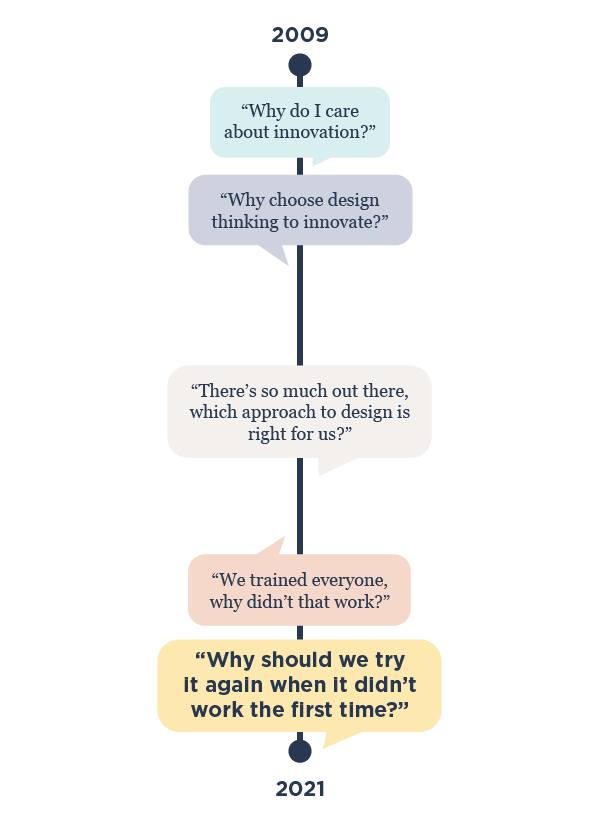When companies engage in a capability-building initiative without considering the long tail, they often face a false start: the secret killer of business transformation journeys. Many organizations only recognize they’ve had a false start once it is already too late–once there has already been a significant investment in training without sustainment infrastructure.
False starts are just as prevalent when it comes to scaling design thinking capabilities across an organization. Mastering design capabilities requires a high degree of unlearning old habits and mindsets. Emotional and practical barriers make design capabilities different from any other capability; design capabilities require specific training and learning frameworks that help employees apply newly learned skills and sustain changed habits. Ultimately, organizations that try to scale design thinking skills with a one-size-fits-all training model fail.
This week’s blog discusses the nature of false starts when scaling design capabilities with ExperiencePoint’s Vice President of Organizational Innovation, Andrew Webster. Drawn from his first-hand experience of working with various Fortune 100 companies, Andrew explores what steps organizations need to take to recover from a false start and how innovation leaders can regain credibility in the eyes of stakeholders when scaling design capabilities.
Q & A
1. What are the most common cries of help that you hear from clients who have experienced false starts when scaling design thinking?
Of the thousands of organizations that have attempted to scale design capabilities or company-wide transformation over the last decade, many of them have followed a similar path. (Fig. 1)
At the start of the global financial crisis (GFC) between mid-2007 and early 2009, corporations weren’t considering innovation, let alone design thinking. However, once living through the GFC, many organizations realized that cost-cutting measures were not enough to survive and succumbed to the idea of implementing innovation. After a few more years, leaders recognized the benefits of design thinking by seeing what other organizations were achieving with design, like Apple and IBM. As a result, training workshops, consultants and frameworks emerged to introduce corporations to design thinking practices.
Fig. 1: Client Concerns Over the Years

Today, the most prominent client concern we hear is, “I have tried scaling design capabilities before, and my credibility was compromised. How is this going to be different than last time?” And, of course, these leaders have reason to be skeptical, given that so many change efforts have floundered in the past. They find themselves working from a deficit, making their journey that much harder.
Organizations must remember that enthusiasm decays into cynicism quickly. Consider someone who has gone to a fitness class or two, thoroughly enjoyed the experience, but found that they stopped going to the gym a few months later. With time, their wellness declined, and they became resentful over the money spent on those classes and were hesitant to spend any more money on something gym-related.The enthusiasm that once motivated the individual turned into the cynicism that prevented them from subverting their original experience, despite knowing the obvious merits of going to the gym.
Just as innovation leaders become more skeptical with each failed change attempt, employees grow weary too. When approached by new clients who have already experienced a false start, ExperiencePoint frequently hears employees vexingly express that they already understand the benefits to design thinking. What they really need help with is implementing those skills into their daily work lives, indicating a need for a comprehensive sustainment framework.
2. What do false starts look like when trying to scale design capabilities? Are there early indicators that leaders can watch out for?
Barriers and roadblocks are a natural part of the business world—they’re inevitable. A false start is the cumulative effect of barriers tipping initiatives past a recovery point, requiring organizations to start over altogether. Companies seeking to scale design capabilities across their organization, or undertake any business transformation, will likely face several false starts before getting it right. How a business learns from these roadblocks will determine the difference between an exhilarated workforce and an exhausted one.
Frequently, leaders take the time and money to train the majority of their workforce only to realize how difficult it is to scale and sustain learning, let alone bring it into action. Though providing an engaging learning experience is part of the learning journey, the engagement is pointless if there isn’t a thoroughly planned sustainment framework put in place beforehand. Coming to that realization after already training people who are intuitively hungry for new capabilities kills momentum, your credibility as a leader and design thinking as an approach.
There aren’t obvious early indicators of a false start when scaling design capabilities. In fact, leaders will likely get enthusiastic feedback over the initial learning experience because design is inherently compelling. As a result, organizations get misleading signals about the learning experience they provide to employees. They conclude that their training has been successful because of the positive feedback. In reality, training feedback doesn’t tell a story about how well employees have adopted design thinking mindsets and implemented design capabilities. Once workshop participants go back to the ‘tyranny of real life’ and apply newly learned skills to their day-to-day work, it’s apparent that they lack the latitude and support to sustain the new mindset.
3. What steps does an organization need to take to recover from a false start?
The first step to recovering from a false start is taking advantage of the data you collected while failing. Dive deep into that data, observe behaviors, and interview people to identify highlights or positives. The second step requires synthesizing that data for action, asking, “what are we going to do about it? What are we going to do differently this time around?” Make sense of those findings and turn them into actionable plans. The third step focuses on testing. Test, test, test all ideas and plans before launching them to ensure there isn’t a disconnect between initiative and outcomes.
ExperiencePoint went through these steps with a personal care organization struggling to launch products that met customers’ changing needs. By first diving into the available data, the company quickly realized they had trained people to design skin care products based on customer insights without providing an actual mechanism to access them. With our help, the company put a plan to action and arranged for product developers to access customer insights in their development work. Before rolling out the process, we helped the organization test their plan by placing a few developers in front of customers to see what further guidance or support they'd require to make the most of that interaction. By the end of the entire process, the organization could leverage the mistakes to ensure the success of its new, better-planned initiative.
4. How do innovation leaders regain the support of their stakeholders after experiencing a false start?
To regain the support of their peers and stakeholders, Innovation leaders must first identify and acknowledge what didn’t work by focusing on employee feedback and user data. They must ask workers about the training and about the experience of bringing new skills back into work. Only then can innovation leaders turn to their stakeholders with real insight.
Demonstrate to your stakeholder that design is not the problem. We've seen instances where organizations have tried scaling design thinking, and they just didn't see an uptake. For that reason alone, they think design thinking is broken. They say: “It can't work with technical people–design doesn't work here or design is flawed.” That conclusion is a fundamental attribution error. If there was a prick in the tire of my bike, would I say that bikes don’t work? No, I’d say that it’s not working because of the pinprick, and that's a solvable problem.
Scaling Design Thinking Capabilities Requires Empathy
When faced with a whole new way of working and thinking, it’s natural for employees to feel intimidated. Let's respect that people, even those initially excited, can feel threatened as they get deeper into implementing new ways of working. Employees naturally value the process used to measure their success in the past. Changing ways of working and work outputs can alter how they feel about themselves. Empathy is crucial when scaling design capabilities to ensure employees regain a sense of agency and feel empowered by their new knowledge, not intimated.
Scale lasting behavior change with our help.
ExperiencePoint focuses on the human experience in business. Equip your teams with the tools needed to scale behavior change in a way that sticks. Learn more by visiting our suite of innovation capability-building products.

